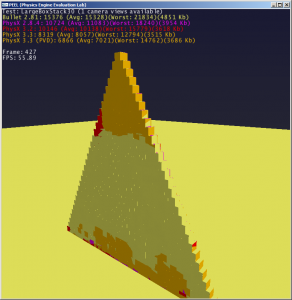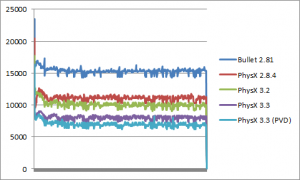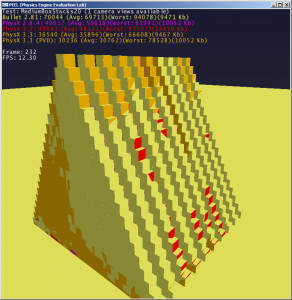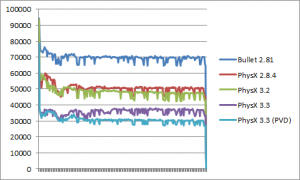The evolution of PhysX (2/12) - Rigid bodies (box stacks)
So let’s start with some basic rigid body simulation: stacks, piles, and mesh collisions. There are two versions of PhysX 3.3 included in these rigid body tests: one using the regular contact generation, and one using the “PCM” method, introduced in 3.3. PCM stands for Persistent Contact Manifold and this algorithm builds contact manifolds iteratively, over several frames. The regular contact generation, on the other hand, builds a full manifold each frame. Both algorithms have pros & cons. Note that as far as I know, both Bullet and Havok have been using the PCM approach for a long time. Anyway the PhysX 3.3 version using PCM is the one marked with “(PVD)” (for completely uninteresting reasons that are too long to explain).
(Click on each screenshot to enlarge them)
—-
The first scene (“LargeBoxStack30”) is a classical box stack, with a 30-boxes-large base. This isn’t terribly useful per-se in a game, but this is a standard test for stability and performance of physics engines.
I am only testing fairly mature engines here so there is little surprise: they all handle this quite well. In terms of performance we see that each successive version of PhyX is a little bit faster than the previous one, which is what we ideally expect to see in all tests. Bullet gives decent results but remains slower than all PhysX versions - and in particular up to 2X slower than PhysX 3.3/PCM.
Nothing very interesting yet in terms of memory usage, all libraries are close, which is expected for such a simple scene.
If you look at the graph closely you will see that a whole bunch of things seem to happen in the first frame, which takes significantly more time to execute than subsequent frames. This is due both to cache effects (nothing is in the cache the first time), and mainly to the initial creation of various scene-related structures (broadphase, etc). This concerns all engines and it only affects the first simulation frame, so we can ignore them in this case.
One interesting thing to note is that this box stack eventually collapses after a certain time, for all engines except PhysX 2.8.4. This is not because PhysX 2.8.4 has more stable algorithms. This is only because it uses the “adaptive force” feature, which was a rather crude hack we used to increase the stability of stacks. It is still available in PhysX 3.x, but we found out it created various side-effects in various cases. Since large stacks aren’t very common in games, we just disabled this feature by default.
Finally, it is worth noting that we have several R&D projects in the pipe, making this stack (and much larger ones) completely stable. I may release a small proof-of-concept demo later, it’s good stuff.
—-
The second scene (“MediumBoxStacks20”) is quite similar, there are now 10 stacks, each of them with a 20-boxes-large base.
Contrary to the larger stack seen before, those stacks don’t collapse in any of the involved engines. Compared to the first one, this test captures performance issues in engines that have a high per-simulation island cost (since there are 10 islands here instead of 1). This does not actually affect any of the engines tested here though, and the profile and performance ratios for this test look similar to the first one. No big surprise there but one must always double-check instead of assuming, right?
In terms of memory usage, we see that PhysX 3.2 is less efficient than the other engines, but the numbers look quite similar otherwise. Comparing memory usage is not always easy since some engines may pre-allocate various buffers to avoid runtime memory allocations, producing an artificially high memory usage number – i.e. they allocate memory that they do not actually need yet. In any case the numbers are roughly similar here. No big winner.




May 29th, 2013 at 1:34 am
Is this Physx on CPU or GPU? If GPU, which one?